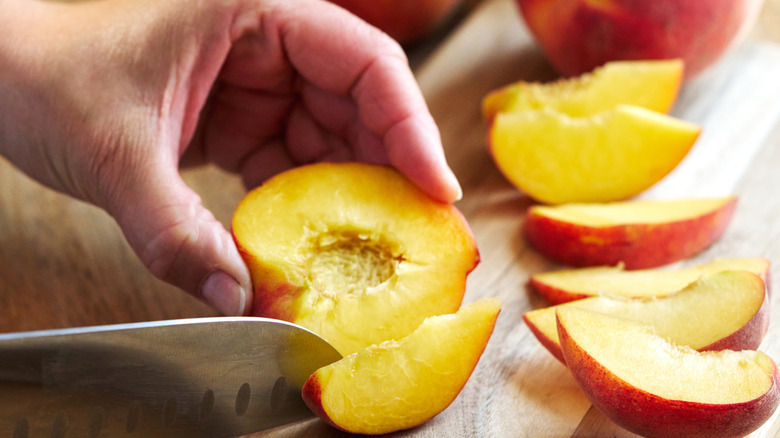The Best Peach Pies Are Made With These Types Of Peaches
Peach pie may not be "as American as apple pie," as the saying goes, but a good peach pie is still a legendary dessert in many states like Georgia and Delaware. Not all peaches are the same, however, so it can be tricky to find the best varieties for baking. To get her expert insight, we spoke to Vivian Villa, chef and founder of UnButter, about which peaches are best for pies.
"Peaches with firm flesh that can be easily pitted are best suited for pies," she said. These are called freestone peaches, which have pits that fall out of the fruit when you cut them open. On the other hand, clingstone peaches have pits that are stickier and tougher to remove — requiring practice before you bake with them. Semi-freestones also have easily removable pits, but taste closer to clingstone peaches.
Villa prefers a semi-freestone variety (although many orchards call them freestone) known as the Babcock peach. "Babcock peaches are the choice for those who prefer tart over sweet — the addition of brown sugar with knobs of butter rounds the tartness out," she said. If you prefer sweet flavors over tart ones, Villa suggests you look for baby gold peaches instead. Peach varieties that bake well generally perform beautifully in any pastry, so Babcocks can shine in a crisp, cobbler, crumble, or galette.
Differences between Babcock and baby gold peaches
Your standard Babcock peach is aromatic and white-fleshed. Although white-fleshed peaches often taste sweet, the Babcock is also a little tart. Bakers often enjoy working with this variety, but many add sugar to sweeten up the final pastry. On the other hand, baby gold peaches are yellow, naturally sweeter, and hold their shape well. You should be warned that baby gold peaches are clingstone fruits, so the pits will put up a fight. Remove them correctly and you'll be rewarded with a sweet, flavorful pie.
To prep your peach pie, Vivian Villa suggests removing the skins first. "Sliced, peeled peaches gently cooking in their own juices — combined with starch — yields a creamy texture with some chunk perfect for a pie filling," she said. Flour can be used to thicken the filling, though cornstarch is another thickener option for your juicy fruit pie. You can blanch peaches to remove their peel, or boil them until the skin is easy to remove. "Blanched peaches with skins that have been removed, pureed until smooth, then added back into the pan, provide thickness and color, reducing the amount of starch required," Villa said. After pulling your dessert from the oven, it should be ready to eat soon afterward, though it's ultimately a personal preference of whether to serve fruit pies warm or cold.

